Peter Dornauf – 19 November, 2013
We know what’s good for you!
Curator, Kim Paton, has been involved in an on-going series of exhibitions at Ramp Gallery, Wintec, which have explored the pressing questions of how to deal with the nature of social space; what should occupy it, how that process should be conducted and critique of past practice. Urban planning and design together with the so-called democratic process have come under scrutiny throughout this series of shows, Public Good being the current offering, augmented this time by a public discussion/conversation that included a panel consisting of artist Julia Morison, Gradon Diprose and Elisapeta Heta.
The question under discussion revolved around the issue of public art. “This is public art?” was how the debate was provocatively posed. Chaired by Waikato artist and Wintec tutor, Tim Croucher, the complex nature of the subject was soon made apparent. The discussion began with attempts to explain why public art might be beneficial, reflecting on the growing fashionable trend for cities in New Zealand to acquire and commission sculptural works to adorn a plethora of public spaces. The focus shifted to Christchurch, post- earthquake with Julia Morison commenting on how the nature of public art has changed in a city where traditional institutions have been forced to shut down. What has emerged in its place is a more grassroots and community orientated response to fill the gap. Indeed “Gap Filler” became the name of one community based initiative encouraging artists, architects, designers, dancers and others to create temporary, small scale art events on vacant sites around the city as a way of contributing to urban regeneration. People power in the arts, in other words, as opposed to “passively waiting for the professionals to do the job”.
Wellington’s Letting Space was another example of the same venture, arising in response to the recession where “pop-up” art ventures use empty commercial property with help from Creative New Zealand and Council.
This creative diversity and more inclusive practice was seen by Gradon Diprose and Elisapeta Heta as a new model for the future in the use of public space in relation to the arts. In discussion that followed some were highly critical of traditional processes that excluded public input. In this context, Morison referred to a case in Christchurch where the Cathedral had been walled off, effectively excluding any public interaction with a building, one that held special cultural and spiritual significance for community. The fact that the wall had commissioned art works painted on it became simply ironic and symbolic of the “we know best” attitude from authorities who had simply ended up clumsily disenfranchising ordinary people.
In this regard, contributing artist Stuart Shepherd lamented the fact of the dearth of collections of folk art in public institutions. However it does seem that in the messy traditional process with regard to the choice, selection and establishment of public art, what we seem to end up with, at least here in Hamilton, and perhaps in other cities too, are by default a smorgasbord of stuff that finds its way into the public arena. Images of bulls and cows out of the school of Walt Disney jostle with socialist realist historic figures, conventional koru creations and abstract metal concoctions. Nevertheless even here the process still involves what some regarded as a defunct top-down and arrogant approach to the idea of public art.
As for the show.
Stuart Shepherd’s work, a sound sculpture, is one of those real boundary crossers. The piece is a constructed picket fence the white boards of which are electronically configured to play a tune when a hand is run along the railings. The tune is Smoke on the Water, rock anthem from the 70’s, a time when a young Shepherd was out early doing his paper round in Hamilton, drum rolling his papers along the fences as he rode by. Some of those real fences he has photographed, twenty four in total, mostly old villas with picket fences, and hung abutted together in two rows along the gallery wall. The sculpture becomes a wonderful and simple salutation of the ordinary, the quaint, the cute, even the clichéd as the music ignites, as Shepherd says, “the bland, the orderly and the sensible.”
Elisapeta Heta’s work, Mega Mall, is a documentation of interviews with an urban planner and members of the St Luke’s Community Organization which traverses the old story, played out over and over in many towns and cities throughout New Zealand which sees a group of people at odds with the decision making of Council, often involving a tale of the little guy set against the corporates who want to expand or demolish something for capitalist reasons at the expense of the public good. The documentary makes clear how the cards are stacked against the local residents from the beginning. Money and the multinationals make heaven and earth move irrespective of the wishes of the community.
A small installation of trees by Anthony Cribb completes the trio of exhibitors. The three small potted plants, rimu, hollywood juniper and totara, covered in a plastic sheeting, together with a small 3D model of how it will look when the trees are planted, tries to conjure some sort of vision of the future for this artist. It is accompanied by ‘development pamphlets’ entitled Totara Heights with computer constructed images of full grown trees (an “artist’s impression”) where each tree is encircled at the base by a marbled stepped enclosure. The set comes complete with a video ‘presentation’ that follows the artist walking through Totora Heights in Manurewa passing comment on local history, urban development, landmarks and public sculpture. Whether all of this is utopian in spirit or partly satirical - nature artificial and homogenised for urban space, the whole installation does present as a little forlorn, or as Paton herself describes it, “like a kind of dysfunctional futurist showroom” in need perhaps of a spirit of revolution, maybe a few cords from Deep Purple to get things smoking.
Peter Dornauf
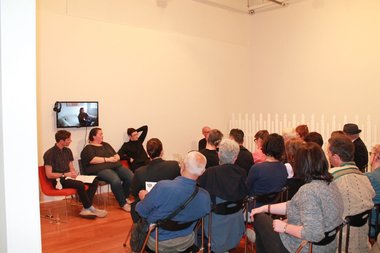

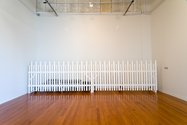
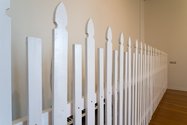
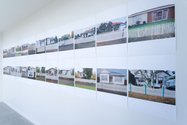
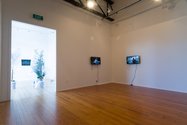
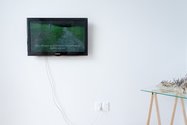
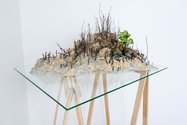
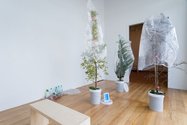
 Two Rooms presents a program of residencies and projects
Two Rooms presents a program of residencies and projects Advertising in this column
Advertising in this column



This Discussion has 0 comments.
Comment
Participate
Register to Participate.
Sign in
Sign in to an existing account.